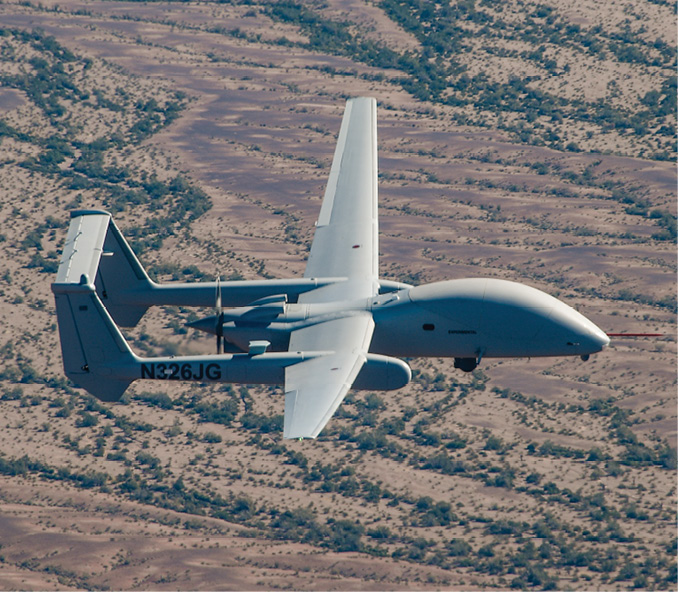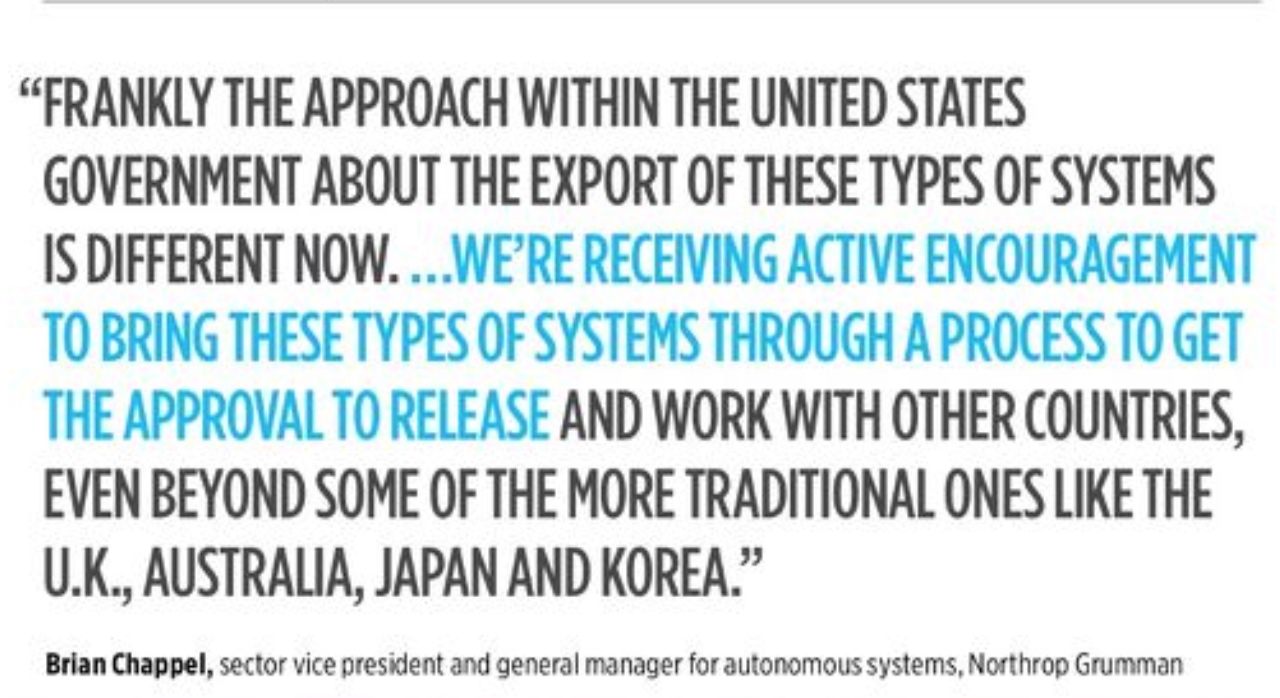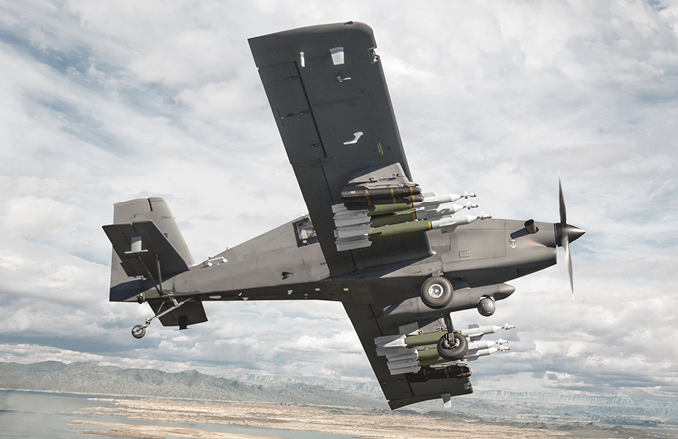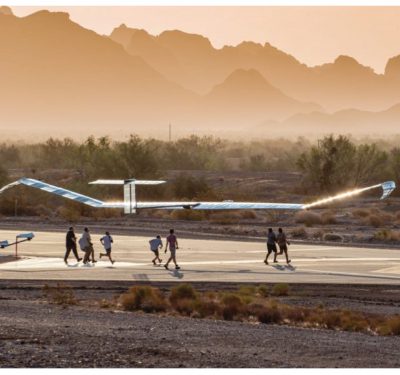
The White House eased drone export rules in April 2018, responding to both strategic realities and pressure from U.S. firms that were losing out on lucrative deals. The revised rules have captured the attention of some defense companies, sharpening their focus on international sales and even inspiring design decisions that could make their drones both more competitive and easier to export—key factors in a sector where China has sold systems to at least a dozen countries and other new competitors are emerging.
“Frankly, the approach within the United States government about the export of these types of systems is different now,” said Brian Chappel, Northrop Grumman’s sector vice president and general manager for autonomous systems. “…We’re receiving active encouragement to bring these types of systems through a process to get the approval to release and work with other countries, even beyond some of the more traditional ones like the U.K., Australia, Japan and Korea.”
Triggering the change were American manufacturers of military drones who had long complained that U.S. export rules put them at a competitive disadvantage. Though the Obama administration made some revisions, the Trump administration decided to ease export controls more substantially after California-based General Atomics, which builds the Predator and Reaper unmanned aircraft systems (UAS), lost already-negotiated sales to Saudi Arabia and the United Arab Emirates to a Chinese competitor at the last minute.
“General Atomics got quite upset and spoke to people in Congress and people in the DOD [Department of Defense], and made it clear that the policy, the ongoing policy regarding drone sales, was hurting U.S. sales into a region which had traditionally purchased high-tech U.S. systems,” said Steve Zaloga, a senior analyst with Teal Group Corporation and an expert on the market for military drones.

The Firebird from Northrop Grumman. Northrop Grumman
STRATEGIC BREAKDOWN
Sales by China were also undermining the core reason for the controls in the first place—nonproliferation of unmanned military technology. China was willing to sell UAS to countries the U.S. would not deal with and do so without putting restrictions on the use of their drones, as the U.S. had
done, said Josh Schwartz, a doctoral student at the University of Pennsylvania and an expert on drone export rules. At least a dozen nations have already bought Chinese military drones. For example, Algeria, Nigeria, Jordan, Zambia, Iraq, Ethiopia, Turkmenistan, Pakistan and Myanmar have purchased the Rainbow CH-4, an armed Chinese UAS similar to the U.S. Reaper, according to a May 2018 article in Foreign Policy.

“In the past, U.S. drone policy reflected a belief that if the United States restrained from exporting armed drones by strictly adhering to the MTCR (Missile Technology Control Regime) then other states, especially ones that regularly abuse human rights, could not acquire them,” wrote Schwartz and Michael C. Horowitz, professor of political science at the University of Pennsylvania, in the Washington Post last year. “However, according to our ongoing research, about 20 countries now have armed drones. This includes many countries with questionable human rights records, such as Iran, Egypt, Uzbekistan and Burma.”
Policy experts pointed to other considerations as well.
“Withholding military technology from close allies and partners can strain security relationships. Since these partnerships are grounded in trust, shared interests and common threats, partners may equate a state’s unwillingness to export drones with waning loyalty and commitment to other security agreements,” wrote Erik Lin-Greenberg, a political science Ph.D. candidate at Columbia University, in a commentary on the site War on the Rocks. Denying exports can also degrade interoperability and effectiveness during coalition operations. Most importantly, he wrote, “Washington loses political and military influence when states turn to other suppliers. When a state transfers arms, it hopes to establish influence in the recipient state throughout and beyond the lifecycle of the weapon system. In the short term, influence is established via agreements to train personnel or maintain equipment. Producer states design training curricula and can withhold future deliveries, parts or maintenance if a recipient takes actions that run counter to their interests.”
The relationships China is building have potentially broad ramifications for other parts of the American aerospace industry, according to Zaloga. China is hoping to use UAS sales to gain entry to markets for other systems, including fighter aircraft, he said. “I think you’re going to see more and more effort on the part of China to help break into that specific market [UAS] as a way to enter more broadly the military aerospace market.”
Zaloga, who has traveled to airshows where Asian technology in particular is more fully on display, said Chinese firms are surging into the military drone sector, which they see as a dynamic market with great opportunity.
“The Chinese companies are extremely enthusiastic. They have been going to great lengths to field a very wide range of armed UAS and endurance [long-range] UAS to address a whole scope of requirements—from systems as small as the early versions of Predator up through Reaper-sized airframes, that sort of thing. They’re offering it across the board. You name a category of military UAS, they are offering UAS—and it’s not a single airframe; it’s multiple, different companies, different Chinese aerospace companies, all trying to get into the market.”
RULES EASED
Under the new U.S. policy drone sales can now to go through the direct commercial sales (DCS) process instead of the more time-consuming foreign military sales (FMS) process. Under DCS, the company negotiates its own deals with a potential customer and the government is not involved in the fulfillment of the contract, according to a chart prepared by consulting firm LM Defense. Under FMS, the government negotiates the sale and gets involved in the deal, assuming the risk of both parties delivering on their ends of the bargain.
A second change is that drones with strike-enabling technology, like laser target designators, will no be longer considered to be “armed” UAS. This should make them easier to export, said Schwartz.
The new policies have yet to trigger sales, but this did not surprise either Schwartz or Zaloga. Military UAS are expensive, negotiations can take years and now some countries have systems from China in their inventory. “It’s going to take the U.S. a little while to get back in there and convince them that they would be better off buying U.S. systems,” Zaloga said.
Even so, Zaloga believes U.S. companies are probably happy with the policy change because it’s likely to be especially helpful for exports of intelligence/surveillance/reconnaissance (ISR) drones, which make up some 95 percent of the defense UAS sold. “If the policy change opens up that chunk of the market or frees up the sale of purely ISR UAS systems—you know like Predator, but not armed versions of Predator—I’m sure the companies are going to be happy.”

OUT-OF-THE-BOX THINKING
Though exporting UAS is now easier it’s still a process firms have to address. Consequently, some nations are buying optionally manned and even manned aircraft, which are covered by less onerous restrictions.
“The United Arab Emirates, when they met resistance to purchasing armed endurance UAS from the United States…they ended up buying a type of aircraft called the Archangel,” said Zaloga. Made by IOMAX, of Mooresville, North Carolina, the aircraft is based on a crop duster, he said. But the version the UAE purchased was an “armed ISR platform that basically mimics the performance of the Reaper UAS system, but it’s piloted.” IOMAX sold the UAE a dozen Archangels, which were used quite extensively in combat in Yemen, he said.
“It highlights one of the issues in this whole controversy about the sale of UAS’s,” Zaloga added. “…The State Department shows no reluctance to allowing U.S. companies to sell armed aircraft to various allied countries that have essentially the same combat capabilities as an armed UAS. But when it comes to armed UAS there is much stronger resistance.”
Northrop Grumman is taking advantage of that reality with its Firebird aircraft. The Firebird can be converted from manned to unmanned operations in a matter of hours, enabling it to be considered an aircraft when it comes to export rules.


From an export point of view, explained Zaloga, “it will only be a UAS if it’s sold that way.”
“[An optionally piloted aircraft] will probably be offered in several packages,” Zaloga added. “One of the packages would be simply as a piloted aircraft and not include a remote flight control system—you know, a ground-based control system to allow it to be operated like a UAS. It would basically only have flight controls that require a pilot.”
The fact the aircraft is built to fly unmanned suggests a customer could seek approval down the line for UAS operations and then buy the hardware to make the conversion.
“It’ll have the servos and all the other aspects of its flight control system that would allow it to be quickly converted over to a UAS if the requirement existed or if the sale had been approved by the United States. So I think that that’s an interesting technical offshoot of what we saw happen because of the sales restrictions,” said Zaloga.
Northrop isn’t the only firm examining optionally manned design, Zaloga noted. “There’s a couple of current companies right now looking at it [the concept] and they have test-flown aircraft that can be flown either as a UAS or as a piloted aircraft.”
Northrop has taken other steps to make the Firebird export-friendly, said Chappel. It has no exotic materials; it has a Lycoming engine like those found in general aviation aircraft and only off-the-shelf commercial systems. Northrop is also working to build a network of commercial sensor suppliers that can add capability without adding export complications.
Chappel said his firm wants to develop a large ecosystem of commercial suppliers to enable Northrop to be able to extend its mission offerings. Depending on location and customer mission, he said, “having a full set and knowledge of different sensing capabilities will allow us to also sell something that’s better matched to whatever a customer needs.”
As for potential clients, Chappel is thinking flexibly too. “So, for example, if we went to a country that perhaps didn’t have as developed of an aerospace industry but they wanted to get into that type of capability we would absolutely…be looking to establish partners and setting them up to be able to do that.”
And where might that be? Chappel suggested the Baltic States or Poland might find the Firebird appealing, as would some nations in the Pacific. He cited key allies like Australia, Japan and Korea, and also Singapore, Indonesia. Malaysia, the Philippines and Vietnam.
“They’re all surrounded by water—and it’s a very interesting part of the world,” said Chappel, “and they have multiple missions to be able to monitor but undoubtedly not big budgets. So they need to have affordable flexibility. So when we think about it, we’re talking in those terms.”






